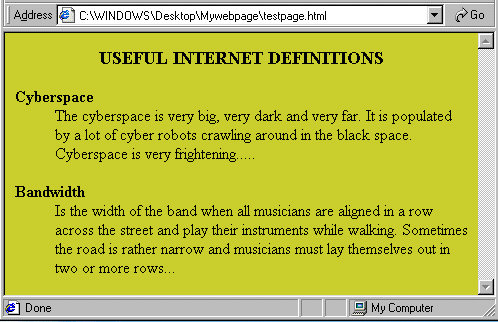

|
by Carlo Scodanibbio |
|
| home | course program | course leader | enquiries | enrol | testimonials | download |
|
Lessons
welcome1 - chapter a 1 - chapter b 1 - chapter c 1 - chapter d 1 - chapter e 1 - chapter f 1 - chapter g 1 - chapter h 1 - chapter i 1 - chapter j 1 - chapter k 2 - chapter a 2 - chapter b 2 - chapter c 2 - chapter d 2 - chapter e 2 - chapter f 2 - chapter g 2 - chapter h 3 - chapter a 3 - chapter b 3 - chapter c 3 - chapter d 3 - chapter e 3 - chapter f 3 - chapter g 3 - chapter h 4 - chapter a 4 - chapter b 4 - chapter c 4 - chapter d 4 - chapter e 4 - chapter f 4 - chapter g 4 - chapter h 4 - chapter i 4 - chapter j 4 - chapter k 5 - chapter a 5 - chapter b 5 - chapter c 5 - chapter d 5 - chapter e 5 - chapter f 5 - chapter g 6 - chapter a |
Finally,definition listsBrowsers can organise nicely another type of List called Definition List.Definition Lists can be used, for instance, for Glossaries and to organise and format text in a rational way. A Definition List is contained between the two Tags <DL> </DL>. They are the container of the Definition List. What is needed within is a number of Definition List Term Standalone Tags <DT>, each followed by another Standalone Tag <DD> (Definition List Data). An example will clarify everything. This code: <BODY> <H3 ALIGN="center"> USEFUL INTERNET DEFINITIONS </H3> <DL> <DT><B> Cyberspace </B> <DD> The cyberspace is very big, very dark and very far. It is populated by a lot of cyber robots crawling around in the black space. Cyberspace is very frightening..... <P> <DT><B> Bandwidth </B> <DD> Is the width of the band when all musicians are aligned in a row across the street and play their instruments while walking. Sometimes the road is rather narrow and musicians must lay themselves out in two or more rows... </DL></BODY> will be displayed by the Browser like this:  REMARKS:
Now I am exhausted. That's all for Lists. You may notice how generous I can be: in this Lesson I have given you only 1 Exercise ! This is because I am confident you will be doing your own experimenting on the topics we have been discussing so far. See you soon, Salutations !!! |
|
previous |
shut-down this HTML story ! |
|